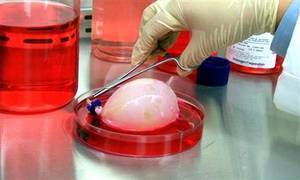Organ Growing
Organ growing is one of the new advances in medicine that would enable organ replacement. Human organs will be replaced internally or externally, using a replacement organ that was “grown” using a tissue or a cell from the patient himself. This new technology will make possible a virtually inexhaustible supply of organ replacements, thereby doing away with the need to wait for organ donors and removing the risk of rejection of an implanted organ. In 1997 alone, less than 10% of the 40,000 patients in the US needing a heart got one. The statistics are more or less the same for those needing new skin, liver or kidneys.
Organ growing aims to combine different disciplines such as genetic engineering, medicine and biology to enable single cells to develop into new organs inside the patient or in a simulated environment. Scientists have already succeeded in the creation of artificial bone scaffolding which forms the base for bone cell growth. Future developments will involve growing complex organs such as the kidneys or heart.
Internal Organ Growing
Neo-organs or man-made organs have revolutionized the way patients are treated. One of the examples for internal organ growing is when biodegradable polymers are used as scaffolding materials for cells which are able to regenerate into whole tissues. The cells then replicate within the wound site and the scaffolding breaks down to be ejected as waste by the body. Another example is when a molecule is injected into an organ or a wound. The injected molecules then act as a migration site for the patient’s other cells. These cells are then made to develop into the right kind of cell – that which is needed to heal the organ.
External Organ Growing
External organ growing has also proved successful as a new bladder has been grown using progenitor cells. This process used molds of structures called bioresorbable scaffolds in the shape of the required organ. The patient’s own progenitor cells were identified and separated through a biopsy and placed in this scaffold to regenerate and grow into the needed organ. After maturing into a full sized organ, it was implanted into the patient where it worked as well as a perfectly health bladder. This process has already been tagged as a better alternative to Cytoplasty (a part of the intestine functions as the bladder) that leads to undesirable side effects and absorption of unwanted elements into the body.
Another method being researched today is using animals to grow human organs. This is done by extracting stem cells from the bone marrow of the patient. The stem cells are then injected into a sheep’s fetus, enabling the sheep to integrate the human cells into its system. When the sheep is born, the organ developed can be harvested and implanted into the patient’s body. Of course, there is a risk of the patient’s body rejecting the organ, but the presence of the patient’s own cells will go a long way into successfully integrating the organ into the body.


Comments - 2 Responses to “Organ Growing”
Sorry but comments are closed at this time.